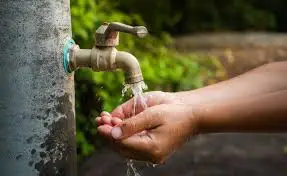Before Central teams hit ground, states scramble to verify Jal Jeevan works

Date: May 26, 2025
Byline: News Circuit Bureau
As inspection teams from the Centre prepare to assess the progress of the Jal Jeevan Mission (JJM), several Indian states are hurrying to complete long-pending verification tasks. The urgency stems from concerns that incomplete or improperly verified rural water supply projects may attract scrutiny or funding delays.
Jal Jeevan Mission: An Overview
Launched in August 2019, the Jal Jeevan Mission is one of India’s most ambitious public infrastructure schemes. It aims to provide functional tap water connections (FHTCs) to every rural household by 2024. While initial momentum was strong, many states have fallen behind in either execution or verification of reported progress.
As per the latest government data, over 75% of India’s rural households have been reported to have tap water connections. However, the real challenge lies in validating these numbers on the ground.
The Verification Rush
With central review teams scheduled to visit multiple districts across the country in the coming weeks, states are rapidly conducting their own internal audits. District collectors, engineers, and gram panchayat officials have been directed to ensure that all claimed FHTCs are physically verified.
In states like Uttar Pradesh, Bihar, Odisha, and Madhya Pradesh, which still lag behind the national average, the pressure is especially high. Reports suggest that some local officials are working overtime, even during weekends, to gather photographic evidence, GPS tagging, and beneficiary statements to validate the projects.
Why Verification Matters
Verification is not just a bureaucratic formality. It directly impacts the fund release from the Centre to the states. Each reported connection must be verified as functional, with regular and safe drinking water supply for a minimum duration each day.
Moreover, verified data helps the Centre understand gaps in infrastructure, operational challenges, and areas needing technical intervention. It also helps assess whether states are meeting their Service Level Agreements (SLAs) under JJM.
Challenges on the Ground
Despite the scramble, ground-level verification faces multiple hurdles:
- Incomplete infrastructure: In several villages, tap connections exist, but water supply is erratic or nonexistent due to lack of source sustainability or power issues.
- Data mismatch: Discrepancies between data uploaded on the JJM dashboard and what exists on-site is causing anxiety among field staff.
- Manpower shortages: Gram panchayats, which play a central role in verification, often lack trained personnel or digital tools.
- Beneficiary confusion: In some cases, families are unaware that their tap connection is part of JJM, affecting documentation.
The Centre’s Perspective
The Union Ministry of Jal Shakti has made it clear that quality and sustainability are as important as quantity. A senior ministry official stated, “We are not just looking for numbers. We want to ensure every household has a reliable, clean water supply. Verification ensures accountability.”
In 2024–25, the Centre allocated over ₹70,000 crore for JJM. With such massive public funds involved, the emphasis on transparency has grown. The inspection teams are expected to check a random sample of villages across all states, with focus on both high-performing and under-performing regions.
State Responses
Gujarat and Telangana
States like Gujarat and Telangana, which have already declared 100% rural tap water coverage, are confident about the inspections. Their officials have been working on strengthening water quality testing and maintenance of village-level infrastructure.
Bihar and West Bengal
In contrast, states like Bihar and West Bengal are facing challenges due to pending work and alleged data inconsistencies. Emergency meetings have been held at the district level to coordinate last-minute verification drives.
Kerala and Himachal Pradesh
These states have taken a proactive approach, having implemented third-party audits months in advance. Kerala, in particular, is focusing on real-time data validation through mobile apps and community engagement.
Public Participation and Awareness
The Centre has also encouraged community involvement in the verification process. Village Water and Sanitation Committees (VWSCs) are being trained to maintain basic records and assist in grievance redressal.
Citizens are being asked to verify their water supply through SMS or app-based tools, a move aimed at increasing transparency and reducing chances of inflated claims.
Looking Ahead
As India inches closer to the Jal Jeevan Mission deadline, these inspection rounds could be pivotal in determining the success of the initiative. While states continue their last-minute efforts to present a clean report card, the coming months will reveal how effective the mission has been — not just on paper, but on the ground where it truly matters.
Whether these pre-inspection scrambles are enough to meet the Centre’s expectations remains to be seen. One thing is clear: water delivery is no longer just a rural infrastructure challenge — it’s a measure of administrative credibility.






